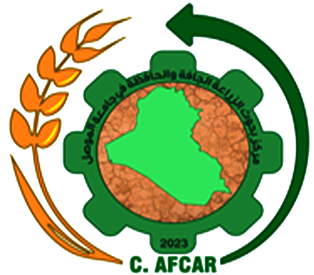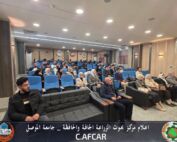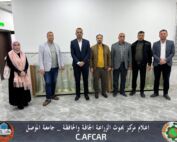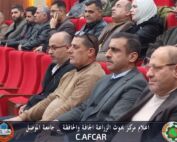19 مارس، 2024
مقدمة عن الزراعة الحافظة في العراق

إعداد أ.د. عبدالستار أسمير الرجبو
مدير مركز بحوث الزراعة الجافة و الحافظة في جامعة الموصل
Prepared by Prof. Dr. Abdulsattar Asmair Alrijabo
Director of Center for Arid Farming and Conservation Agriculture Research’s (CAFCAR) at University of Mosul
Local leader of the Conservation Agriculture Program in Nineveh province.
عرفت منظمة الأغذية والزراعة الدولية الزراعة الحافظة (CA) الزراعة الحافظة للموارد هي نظام زراعي يشجع على المحافظة على غطاء تربة دائم، والتقليل من اضطربات التربة ( حراثة التربة)، وتنويع أنواع النباتات (دورة زراعية) . كما يعزز التنوع البيولوجي والعمليات البيولوجية الطبيعية سواء فوق سطح التربة أوتحته مما يساهم في زيادة كفاءة استخدام المياه والمغذيات وفي تحسين إنتاج المحاصيل واستدامته.
وعرف الرجبو (2012) الزراعة بدون حراثة ( Zero Tillage ) بأنها القيام بعملية البذار بدون حراثة مسبقة للحقل مع تقليل إثارة التربة لأدنى حد عند عملية البذار , وهي نظرة علمية حديثة إلى تطبيق قديم للعملية الزراعية مارسه الإنسان معتمداً على التوازن البيئي دون اضرار أو اهدار بالمصادر الطبيعية من تربة ومياه ومحتويات التربة العضوية والحيوية.
معلومات عن نقطة الهدف ونظم الزراعة القديمة السائدة في محافظة نينوى شمال العراق كممثل للزراعة الديمية ( المطرية):
تعتبر محافظة نينوى المحافظة الأكثر أهمية في العراق في إنتاج الحبوب لذا تسمى سلة خبز العراق ، تبلغ المساحة الإجمالية لمحافظة نينوى 32308 كيلومترا مربعا. ضمنها المنطقة الزراعية البالغة حوالي 1640000 هكتار. يتم تصنيف الأراضي الزراعية في محافظة نينوى وفقا لمعدلات الأمطار إلى 3 مواقع ، الأول عالية الأمطار أكثر من 500 ملم والثاني متوسط الأمطار من 300- 500 ملم والثالث محدود الأمطار من 200- 300 ملم . وتشكل الزراعة المطرية في نينوى نحو 95٪ من الأراضي الزراعية والباقي 5% أراضي مروية ريا تكميلياً.
نظام الزراعة في المناطق محدودة الأمطار المحصول السائد هو الشعير لتحمله للجفاف , المزارع في هذه المناطق يستخدم القرص البذار Disc seeder في الزراعة . إن من مضار الزراعة بالقرص البذار أنه لا يمكن تحديد عمق البذار بصورة صحيحة , ولا يمكن تحديد معدل البذار بصورة صحيحة , كما يسبب تعرية شديدة للتربة.
FAO defined Conservation Agriculture as a farming system that promotes minimum soil disturbance (i.e. No tillage), maintenance of a permanent soil cover, and diversity of plant species. It enhances biodiversity and natural biological processes above and below the ground surface, which contribute to increased water and nutrient use efficiency and to improved and sustained crop production.(8)
Alrijabo (2012) defined zero tillage as implementing the sowing process without pre plowing the field with minimizing soil disturbance at the sowing process, zero tillage is a modern scientific vision for an old application of sowing process that was practiced by man depending on the environmental balance without any harm or waste of natural resources of water, soil and its organic and vital components.(2)
Information about the target point and the old farming systems prevailing in Nineveh Province, northern Iraq, as a representative of rain-fed agriculture:
Nineveh Province is considered as the most important province in Iraq in cereal production, so it is called the bread basket of Iraq. The total area of Nineveh Province is 32,308 square kilometers, including the agricultural area which about 1.64 million hectares. The agricultural lands in Nineveh Province are classified according to the rain rates to three regions, the first is a high rainfall area HRA (more than 500 mm), the second is a moderate rainfall area (300-500 mm), and the third is low rainfall area LRA (200 – 300 mm). Rain-fed agriculture in Nineveh constitutes about 95% of agricultural land, and the rest 5% is irrigated land as supplementary irrigation.(2)
Farming system in Low Rainfall Area LRA region: The prevailing crop is barley due to its drought tolerance. Farmers in these areas use a disc seeder in sowing. One of the harms of sowing with a disc seeder are the seed depth cannot be determined correctly, and the seed rate cannot be determined correctly, and it also causes severe soil erosion.
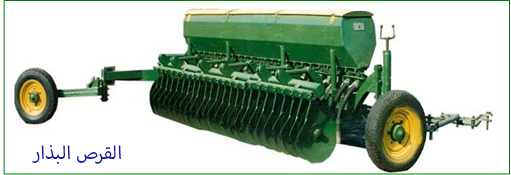
رغم ما تقدم فإن المزارع يستخدم القرص البذار لكونه مسحوب لا يحتاج هيدروليك ويكفيه ساحبة قدرة 70 حصان لسحبه . الدورة الزراعية في المناطق محدودة الامطار هي دورتان إما تبوير (شعير – تبوير –شعير) وتتضمن أربع خطوات : الخطوة الأولى انتظار المطرة الغزيرة الاولى ( البلة) لإنبات بذور الادغال في الحقل ثم الحراثة الشتوية (الحراثة الأولى) للقضاء على الادغال. الخطوة الثانية : إن أمطار الربيع تعيد ظهور نباتات الادغال فيتطلب الحراثة الربيعية للقضاء على الادغال ( الحراثة الثانية). الخطوة الثالثة : الحراثة الخريفية لتنعيم التربة ( الحراثة الثالثة) . الخطوة الرابعة : بذار الشعير . ويتم البذار في هذه المنطقة بالقرص البذار. أما الدورة الثانية : شعير – شعير فتكون مستمرة والبذار يكون إما قبل أو بعد سقوط المطرة الغزيرة الأولى.
نظام الزراعة في المناطق شبه مضمونة الأمطار: المحصول السائد هو الحنطة الناعمة 60 – 80% والشعير 40- 20%. الدورات الزراعية في المناطق شبه مضمونة الامطار : شعير – تبوير – شعير أو شعير – شعير , أو حنطة ناعمة – تبوير – حنطة ناعمة أو حنطة – حنطة . ولا أكثر من 5% من مساحة المنطقة متوسطة الامطار تطبق دورة حنطة –بقول – حنطة. إن خطوات الدورة الزراعية : مماثلة للمناطق محدودة الأمطار.
نظام الزراعة في المناطق مضمونة الامطار: المحصول السائد هو الحنطة الناعمة 80% والحنطة الخشنة 20%. الدورات الزراعية في المناطق مضمونة الامطار :حنطة خبز – حنطة خبز , وحنطة خشنة – حنطة خشنة, وليس أكثر من 10% دورة حنطة – بقول – حنطة. خطوات الدورة الزراعية : دائما انتظار سقوط المطرة الغزيرة الأولى ثم انتظار بزوغ نباتات الادغال ثم الحراثة بالقرص البذار تليها الزراعة بالباذرة الحديثة.
نظام الزراعة في المناطق تحت الري التكميلي: المحصول السائد هو الحنطة الناعمة 80% والحنطة الخشنة 20%. الدورة الزراعية تحت الري التكميلي : حنطة خبز – حنطة خبز , وحنطة خشنة – حنطة خشنة , و 10% دورة حنطة – بقول – حنطة. وأحيانا تزرع الخضروات في حال توفر مياه كافية . خطوات الدورة الزراعية: رش الحقل كبديل عن المطرة الغزيرة الأولى , ثم مكافحة الادغال بالحراثة , ثم البذار باستخدام الباذرة الحديثة.
الأخطار التي تواجه العملية الزراعية في المناطق الديمية ( المطرية) :
1- التغير المناخي في المنطقتين محدودة وشبه مضمونة الامطار :
زيادة مواسم الجفاف في هاتين المنطقتين اللتين تمثلان اكثر من 80% من مساحة الاراضي المزروعة في نينوى
2- التصحر وزحف الرمال وتغطيتها للدور الطينية لسكان القرى أجبر سكان 15 قرية في ناحية تل عبطة في نينوى على هجرة قراهم ( الصورة من قبل د جاسم خلف شلال).
Despite of that, the farmer uses the disc seeder because it is drawn machine, does not need hydraulic equipment, and it is able to be drawn by 70 HP capacity tractor. There are two crop rotations in LRA regions, first (barley – fallow – barley) crop rotation and it includes four steps: The first step is waiting the first effective rain (more than 30 mm) to germinate the weed seeds in the field, then implementing the winter tillage (first tillage) to eliminate the weeds. The second step is spring tillage to eliminate the weeds too (the second tillage). The third step: autumn tillage to soften the soil (the third tillage). Step four: sowing the barley. Sowing is done in this region by disc seeder.
The second rotation in this region is: barley – barley rotation , it is continuous seasonally sowing of barley , and the sowing is either before or after the first effective rain falls.(4)
Farming system in the Moderate Rainfall Areas MRA region: the prevailing crops are 60-80% bread wheat and 40-20% barley. Crop rotations in MRA are: barley – fallow – barley, barley – barley, wheat – fallow – wheat, or wheat – wheat crop rotations. No more than 5% of this area applies a wheat-legume-wheat rotation. The steps of the crop rotation are similar to LRA.(6)
Farming system in the High Rainfall Areas HRA region: the prevailing crops are 80% bread wheat and 20% durum wheat. Crop rotations in these regions are: bread wheat – bread wheat, and durum wheat – durum wheat, and not more than 10% wheat – legume – wheat. Steps of the crop rotation are: always wait for the first effective rainfall, then wait for the emergence of weed plants, then plowing with a disc, followed by sowing with modern seeder.(1)
Farming system under Supplementary Irrigation SI region: the prevailing crops are 80% bread wheat and 20% durum wheat. Crop rotations under supplementary irrigation are: bread wheat – bread wheat, and durum wheat – durum wheat, and 10% wheat – legume- wheat. Sometimes vegetables are grown if there is enough water. Steps of the crop rotation are: spraying the field as a substitute for the first effective rain, then plowing the field for weed control, then crop sowing with modern seeder .(3)
The risks facing the agricultural process in the rain-fed areas.
1- Climate change in the LRA and MRA regions: Increased drought seasons in these two regions, which represent more than 80% of the area of cultivated land in Nineveh.
2- Desertification, and sand dune coverage of the rural houses of many villagers which forced the residents of 15 villages in the Tal Abata district in Nineveh to migrate their villages (photo by Dr. Jassim Khalaf Shallal).
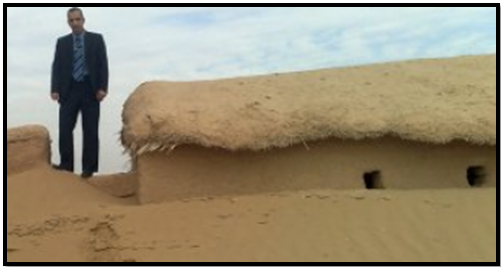
3- إصرار المزارعين على استخدام الحراثات المتعددة للقضاء على الادغال باستخدام الدسك البذار في الزراعة ادى الى تعرية شديدة للتربة وتلوث لهواء القرى والمدن.
3-The farmers’ insistence on using multiple tillage to eliminate the weeds by using a disc seeder has led to severe soil erosion and pollution to the atmosphere of villages and close cities.
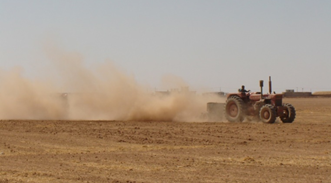
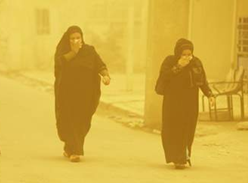
4- الحراثات المتكررة تسبب استهلاكا عاليا للوقود (32 لتر/ هكتار) مما يسبب خسارة اقتصادية للمزارع نظرا لارتفاع اسعار الوقود فضلا عن زيادة تلوث الجو بعادم الساحبات
5- قلة الامطار المتزامن مع ارتفاع معدلات درجات الحرارة
ان نقص معدلات سقوط الامطار مع ارتفاع درجات الحرارة ادى الى قلة مساحة الاراضي المزروعة بالمحصول الاستراتيجي الحنطة وزيادة المساحات المزروعة بالشعير
من أجل ما تقدم تم التخطيط والتنفيذ لبرنامج الزراعة الحافظة الذي كان بإدارة وزارة الزراعة العراقية بالتعاون مع جامعة الموصل وبالدعم المالي والفني من قبل الجانب الأسترالي الممثل بالجامعات الأسترالية والمنظمة الدولية للبحوث الزراعية في المناطق الجافة ( إيكاردا) والذي استمر للفترة من 2005 لغاية 2013 . ولقد حققت الزراعة الحافظة مقومات التنمية الشاملة وكما يأتي :
سعى البرنامج إلى تحقيق ثالوث التنمية الزراعية في منطقة الهدف وهي محافظة نينوى و لنجاح المشروع توسع ليشمل ثلاث محافظات اضافية هي كركوك وصلاح الدين والأنبار حيث غطى البرنامج نشاطات التنمية البشرية والتنمية الاقتصادية والتنمية البيئية وكالآتي:
التنمية البشرية :
شملت التنمية البشرية تنمية القدرات المهارية للمزارعين والموظفين في المحافظات الاربعة لغرض تبديل قناعاتهم واعتماد تقنية الزراعة بدون حراثة من خلال تنفيذ مشاهدات حقلية في حقول المزارعين في نينوى والمحافظات حسب المواقع البيئية فيها . تنفيذ 35 موقع مشاهدة حقلية في حقول المزارعين في نينوى , تنفيذ 5 مشاهدات حقلية في حقول المزارعين في الأنبار , تنفيذ 4 مشاهدات حقلية في حقول المزارعين في صلاح الدين , تنفيذ 4 مشاهدات حقلية في حقول المزارعين في كركوك. كانت البداية لمشروع الزراعة الحافظة مع باذرات زراعة بدون حراثة سكينية المقطع هندية المنشأ بعرض شغال 2 متر فقط وبدون عجلات ضغط وبتنفيذ تجريبي بحثي .
4-multi tillages cause high fuel consumption (32 liters / hectare), which causes an economic loss for farmers due to the high fuel prices, as well as increased pollution of the air by exhaust tractors gases.
5-The lack of rains accompanied with a rising in temperature rates: The decrease in the rates of rainfall accompanied by high temperatures led to a decrease in the wheat cultivated area and an increase in the barley cultivated areas.
According to the previous review, it was planned and implemented a conservative agriculture program in Nineveh province that was administered by the Iraqi Ministry of Agriculture in cooperation with the University of Mosul, with financial and technical support by the Australian side represented by Australian universities and the International Organization for Agricultural Research in the Dry Areas (ICARDA). The program activities started in 2005 till 2013.
The program aimed to achieve the elements of comprehensive agriculture development in the target area, which is Nineveh Governorate, and depending on the success of the project in Nineveh, it expanded to include three additional provinces, namely Kirkuk, Salahuddin and Anbar, where the program covered the activities of human development, economic development and environmental development as follows:
Human Development:
Human development included developing the skills of farmers and employees in the four provinces to changing their convictions about old planting methods, and adopting the new planting method of zero tillage through the implementation of field observations in farmers’ fields in Nineveh and the other provinces according under the different environmental sites in them.
Implementation of 35 observations in farmers’ fields in Nineveh, 5 observations in farmers’ fields in Anbar, 4 observations in farmers’ fields in Salah al-Din, and 4 observations in farmers’ fields in Kirkuk was done. The beginning of the conservation agriculture project was with the zero tillage planting method, by using a small Indian seeder, with a width of only 2 meters, and without press wheel, to use it as a research pilot implementation.


ثم تم التطبيق المباشر في حقول المزارعين بعد أن تم تعريف المزارعين بالتقنية الجديدة وفوائدها وآليات تطبيقها , كما وفر المشروع باذرات ذات عرض شغال أكبر ( 3 و 4 متر) مع عجلات الضغط لاستخدامها في حقول المزارعين واسعة المساحة .
Then the direct implementation was made in the farmers’ fields after the farmers were introduced to the new technology, its benefits and application mechanisms. The project also provided ZT seeders with a wider working width (3 and 4 meters) with press wheels to use it in the farmers’ fields of large scale.

كما تم تدريب موظفي محافظات كركوك والأنبار وصلاح الدين في دورات داخل وخارج العراق ليتحولوا إلى قادة ميدانيين ومرشدين زراعيين للتقنية الحديثة الإدخال .
The staff of the provinces of Kirkuk, Anbar, and Salah al-Din were also trained in courses inside and outside Iraq to be a field leader and agricultural extension agents for the newly introduced technology.(11)




الدورات التدريبية للكادر الوظيفي العامل ضمن برنامج الزراعة الحافظة
Training courses for staff working within the CA program.








أما بالنسبة للمزارعين فقد نفذ البرنامج أكثر من 60 دورة تدريبية وأيام حقل للمزارعين داخل وخارج العراق.
As for farmers, the program has implemented more than 60 training courses and field days for farmers inside and outside Iraq.
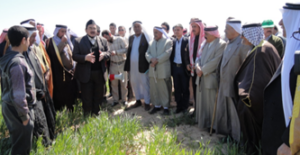
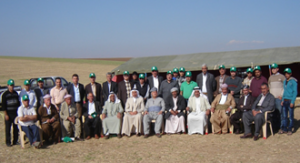

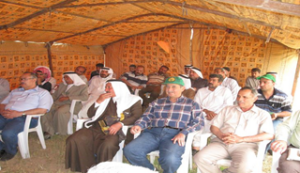


وفي النشاط البحثي والأكاديمي حقق البرنامج كما عالياً من النشاط العلمي ممثلاً في الابحاث العلمية ورسائل الدراسات العليا المنفذة ضمن برنامج الزراعة الحافظة من خلال باحثي جامعة الموصل و باحثي قسم بحوث نينوى
الأبحاث ورسائل الماجستير والدكتوراة 125 بحثا وحسب المخطط.
In research and academic activity, the program achieved a high level of scientific activity, represented in scientific research and postgraduate studies which implemented within the program of conservative agriculture through researchers at the University of Mosul and researchers in the Nineveh Research Department
More than 125 Research papers, Master and PhD theses as in histogram.
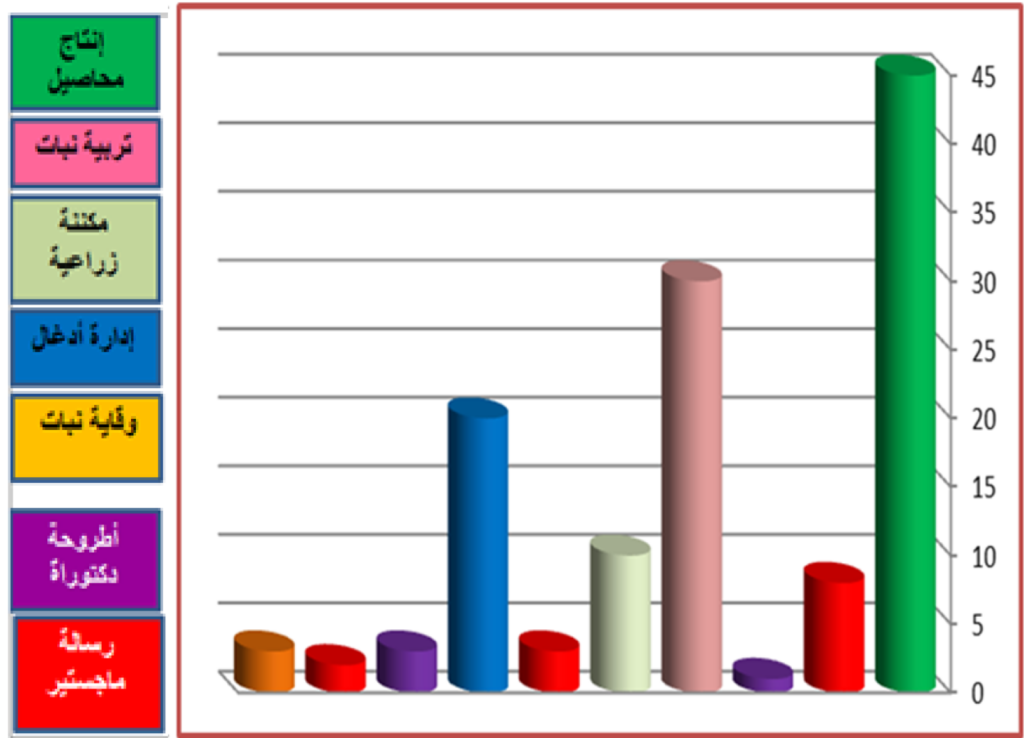
التنمية الاقتصادية :
إن نجاح تقنية الزراعة بدون حراثة من الناحية الاقتصادية أن هذه التقنية تسعى إلى تقليل المدخلات ( من معدلات البذار والوقود وساعات العمل وتشغيل العمالة وصيانة المعدات وكمية المياه المستخدمة للري التكميلي) وفي ذات الوقت تتحقق زيادة في المخرجات للعملية الزراعية لتحسين دخل المزارع . نجح البرنامج أيضا في تعزيز دخل المزارعين والتوسع في الزراعة حسب تقنية الزراعة بدون حراثة حيث يوضح المخطط تقدم في المساحات المزروعة بطريقة الزراعة بدون حراثة (هكتار) في نينوى بدء من الموسم الاول لتطبيق الزراعة الحافظة 2005-2006 ولغاية الموسم الثامن 2012-2013
Economic development:
The economic success of the zero tillage technology is that this technology seeks to reduce all inputs (seed rates, fuel, hours of work, a number of employment, equipment maintenance, and the amount of water used for supplemental irrigation). At the same time an increase in the outputs of the agricultural process is achieved to improve farmer income. The program also succeeded in boosting farmers ’income and expanding in ZT planting method, as the figure shows the progress in the ZT cultivated areas (ha) in Nineveh, starting from the first season 2005-2006 to the eighth season 2012-2013.(10)
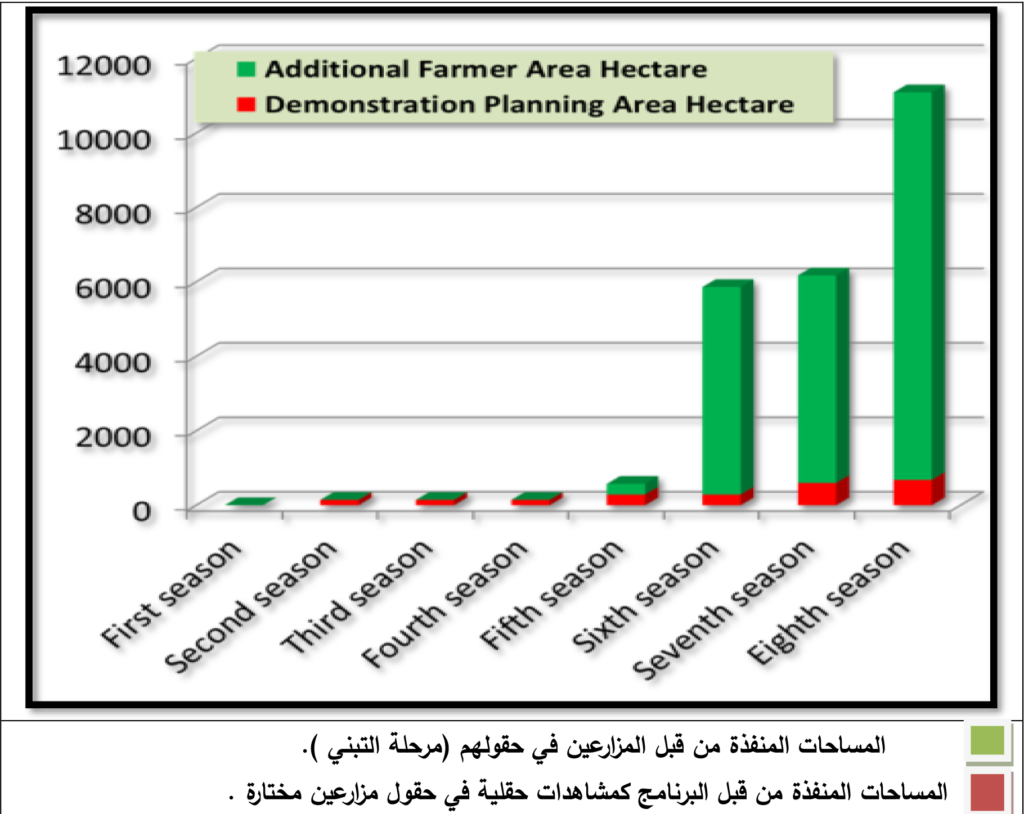
كما نجح البرنامج في التصنيع المحلي لباذرات الزراعة بدون حراثة بالتعاون مع مصنعين محليين ومزارعين رواد .
The program also succeeded in locally manufacturing of ZT seeders in cooperation with local manufacturers and pioneer farmers. (9)
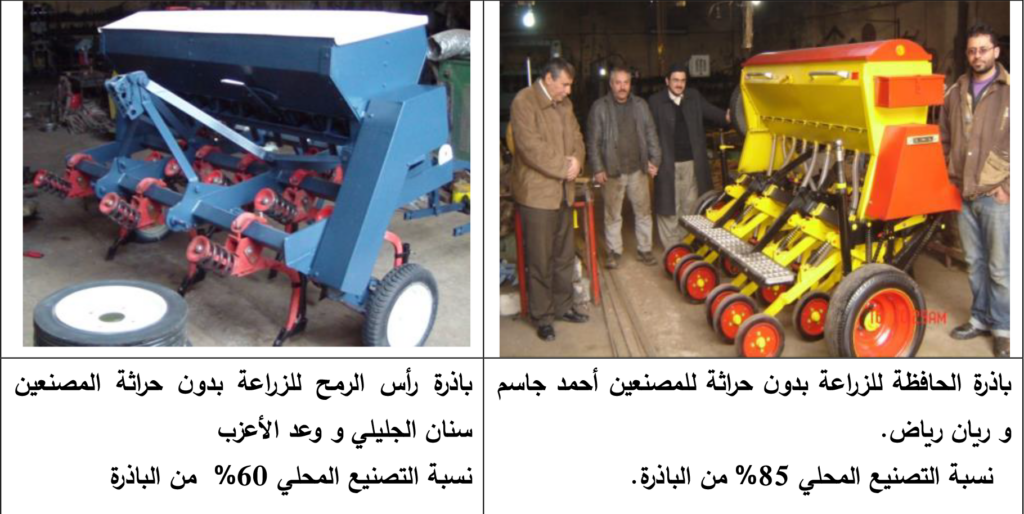
كما قام البرنامج بتحوير 20 باذرة مملوكة للمزارعين من باذرة تقليدية الى باذرة زراعة بدون حراثة
The program also modification of 20 seeders owned by farmers from a traditional seeder to a ZT seeder.(7)
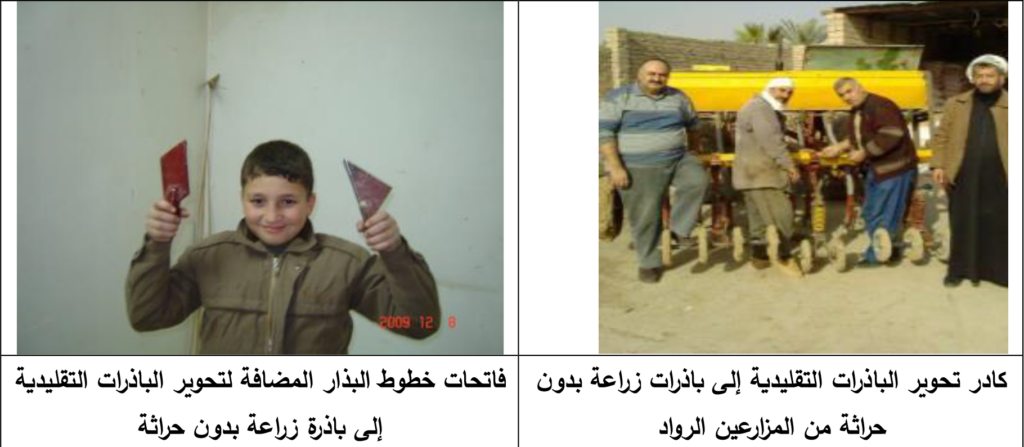
التنمية البيئية:
الحد من ظاهرة التصحر والهجرة من الريف الى المدينة وتعرية التربة وتلوث الهواء بالغبار نتيجة الحراثات المتكررة. حققت الزراعة بدون حراثة خفضاً ملحوظاً في مخاطر التعرية الهوائية لحقول المزارعين المطبقين لهذه التقنية فضلاً عن تقليل التلوث بعادم الساحبات نظرا لتقليل استهلاك الوقود لوحدة المساحة الزراعية.
مجمل فوائد الزراعة بدون حراثة:
إن الفوائد الأساسية التي تحققت في الزراعة بدون حراثة تمثلت في الآتي :-
1-10- تقليص نفقات الانتاج حيث حققت الزراعة بدون حراثة استهلاكاً أقل للوقود (8 لتر / هكتار) مقارنة مع الزراعة التقليدية ( 32 لتر/هكتار) , مع تقليل معدل البذار بنسبة 25% , فضلا عن تقليل استخدام الأسمدة الكيمياوية الى أقل من 50% , مع تقنين في استخدام مبيدات الأدغال و تقليل ساعات تشغيل المكائن الزراعية و بالتالي تقليل استهلاك الأدوات الاحتياطية .
2- إن ترك مخلفات حصاد المحصول السابق فوق سطح التربة وتنظيم الرعي المترافقين مع الزراعة بدون حراثة قلّل أو منع من حدوث أي تعرية للتربة . مع تحسين بناء المادة العضوية في التربة.
3- أعطت الزراعة بدون حراثة مرونة كبيرة في العملية الزراعية من خلال توسيع الوقت المتاح لعملية البذار مع قلة الوقت اللازم لتنفيذها حيث لم يعد المزارع ينتظر المطرة الغزيرة الأولى لغرض المباشرة بالعمليات الزراعية بل أصبح بإمكانه المباشرة بالعملية الزراعة بعد الحصاد مباشرة.مما يعني البذار المبكر مقارنة مع الزراعة التقليدية التي تستوجب انتظار هطول المطرة الغزيرة الأولى.
4- مع الموسم الثالث من توالي استخدام الزراعة الحافظة انخفضت أعداد الأدغال في الحقول الزراعية الى أدنى حد بحيث لم يعد الأمر يستوجب إجراء المكافحة الكيماوية لها .
5- خفضت الزراعة الحافظة من معدل البذار المستخدم لمحصول الحنطة في الزراعة التقليدية ( من 160 كغم/هكتار في الزراعة التقليدية إلى 100 كغم/ هكتار في الزراعة بدون حراثة)
6- تحسين قدرة التربة على الاحتفاظ بالماء من خلال تقليل جريان الماء السطحي الذي يؤدي إلى فقدان الماء . وتقليل تبخر الماء من سطح التربة . مع حصاد مياه أمطار في حقل الزراعة بدون حراثة أكثر بكثير من الزراعة التقليدية أستغّل لنمو المحصول خاصة تحت الظروف الديمية الجافة وشبه الجافة.
7- كان لدور عجلات الضغط المضافة للباذرة دور كبير في تنظيم مقطع خط البذار وحصاد مياه امطار أفضل فضلا عن رصّ التربة فوق خط البذور وزيادة اتصال الحبوب بالتربة وبالتالي سرعة انباتها ونموها .
8- في الزراعة بدون حراثة وتحت الري التكميلي تحقق تقنين في استخدام المياه في الحقول المروية ريّاً تكميلياً مقارنة مع الزراعة التقليدية.
Environmental development: Conservation Agriculture Reduced desertification and rural migration from the villages to the cities reduce soil erosion and air pollution which was a result of severs tillage’s.
The ZT technique has achieved a noticeable reduction in the risk of wind erosion in fields applied to this technology, in addition to reducing pollution by the tractor exhausts due to the reduction in fuel consumption per unit of agricultural areas.
Total benefits of Zero Tillage:
The main benefits achieved in Zero Tillage were as follows:
1- Reducing production expenditures (outputs) where cultivation without tillage (ZT) achieved lower fuel consumption (8 l / ha) compared to conventional cultivation (32 l / ha), while reducing the seeding rate by 25%, as well as reducing the use of chemical fertilizers to less than 50%, with rationing In the use of herbicides and reduce the operating hours of agricultural machinery, and thus reduce the consumption of spare tools.
2-Leaving the harvest residue of the previous crop above the soil surface reduced or prevented any soil erosion. With an improvement the building of organic matter in soil.
3-The ZT gave great flexibility in the agricultural process by expanding the available time for the sowing process, with minimized the required time of sowing. The farmer no longer waits for the first effective rain to start plowing (as in conventional Tillage), but rather he can start the sowing process immediately even after the harvest.
4-With the third season of continuous use of conservative agriculture, the number of weeds in fields decreased to a minimum level, so that chemical control was no longer required.
5-Conservation agriculture reduced the sowing rate used for wheat (from 160 kg / ha in conventional tillage to 100 kg / hectare in zero tillage.(
6-Improving the soil’s ability to retain water by reducing surface runoff and reducing water evaporation from the soil surface. In addition to the highest water harvesting in ZT field compared with CT field.
7-The press wheels which added to the ZT seeder had a great role in organizing the seed line section, harvesting better rainwater, as well as compacting the soil over the seed line and increasing contact between grains and soil, and thus the enhanced grain germination and enhanced growth.
8-Under supplementary irrigation, the ZT achieved high legalization in the use of irrigation compared to conventional agriculture.

9- حسنّت الزراعة بدون حراثة من نمو البادرات وسرعة بزوغها في الحقل مقارنة مع الزراعة التقليدية . و اصبح بمقدور المزارع الحصول على حاصل أوفر وبكلف أقل.
10-وأخيرًا ، جعلت تقنية الزراعة بدون حراثة أن من الممكن إنهاء جميع دورات المحاصيل التي تطبق نظام التبوير (محصول – تبوير- محصول) ، واعتماد الزراعة المستمرة للمحصول دون انقطاع ، مما عزز دخل المزارع بشكل كبير. [5) (12)
9- Zero Tillage improved the seedling growth with rapid emergence in the field compared to conventional tillage. Farmers now are able to obtain a higher yield with lower costs.
10-Finally, Zero Tillage made it possible to ending all the crop rotations that apply the crop-fallow system, and adopt the continuous cultivation of the crop without interruption, which greatly enhanced the income of the farmer.(5) (12)
References
1- Al-Juburi, Neama Hussein and Abdulsattar alrijabo (2012) A study of growth, yield and its components traits of new varieties of wheat and barley crops grown in different environmental regions in Nineveh Province. Mesopotamia Journal of Agriculture, vol. 40, Supplement (1), pp. 94-104. 2012.
2- Alrijabo, Abdulsattar (2012) Sustainable Agricultural development -access mechanisms study. Seminar of sustainable development presented in College of Engineering – University of Mosul. 2012
3- Alrijabo Abdulsattar A.(2012) Effect of the new farming system –Zero Tillage in growth, yield and its components of bread wheat and durum wheat crops under supplementary irrigation in Ninevah province . Minia International Conference for Agriculture and Irrigation in the Nile Basin Countries, El-Minia, Egypt..p 576-585. 26 -29 March 2012
4- Alrijabo Abdulsattar A. (2012) Effect of the new farming system Zero Tillage in growth, yield and its components of barley crop in low rainfall area in Ninevah province. Iraqi J. for Soil Science. Vol. (12) No.(1).p 178-188. 2012.
5- Alrijabo, Abdulsattar and Abdul Rahman Al-Ajrawi (2013) The effect of cultivation methods, row spacing and the addition of polymer jell in growth, yield and its components of wheat crop Triticum aestivum L. Kirkuk University – the second international scientific conference for agricultural research. 30-31 October 2013.
6- Alrijabo Abdulsattar A.(2014) Effect of the new farming system Zero Tillage in growth , yield and its components of bread wheat , durum wheat and barley crops in moderate rainfall area in Ninevah province. Mesopotamia J. Agric. Vol. (42) No. (1). 2014.
7- Abdulsattar A. Alrijabo. Saad A. Asmair Hisham Abdulrahman Ahmed92014) Effect of zero tillage system, seeding rate and row spacing on growth, yield and its components of bread wheat in moderate rainfall area in Nineveh province. Journal of Kirkuk University for Agricultural Sciences Vol. (5) No. (1) 2014
8- Asmair, Saad Abdul-Jabbar, Abdulsattar Alrijabo and Husham Abdullah (2013) assessed the performance of the modified Caspardo seeder to work under zero tillage system in wheat crop cultivation. University of Kirkuk – the second international scientific conference for agricultural research. 30-31 October 2013
What is Conservation Agriculture? (9- FAO publication (2015
10- Jalili S.,Fathi G,Fathi Y, Alrijabo Abdulsattar A.,Piggin C.,Desbiolles J.(2011) Farmer innovation: seeder fabrication and uptake of zero tillage in Iraq. In: Proc. 5th World Congress on Conservation Agriculture, Brisbane Australia, 26–29 Sep, pp. 306-308.2011.
11- Loss S., Feindel D., Haddad A.,Khalil Y. Alrijabo Abdulsattar , Piggin C.(2013) Adoption of conservation cropping in dry land regions of northern Iraq and Syria. Proc. of the Int. Conference on Development of Dry lands, Beijing China. Mar. 2013.
12- Niama H. darweesh , Abdulsattar A. Alrijabo and Hadi A.Abdullah (2013)The effect of tillage system in yield and its components of bread wheat in Salahaldin province-north of Iraq. Fourth agriculture scientific conference- Anbar Univ.2013
13- Nineveh vision 2030 (2011) Chapter – Agricultural development and access mechanisms- Alrijabo Abdulsattar. Nineveh province pub. Mosul
